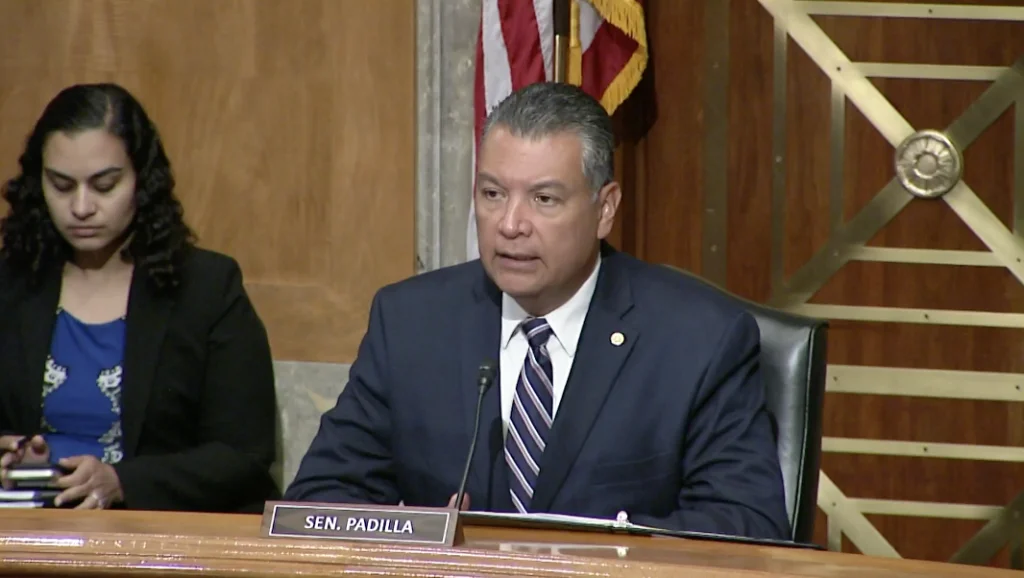Padilla Questions Census Bureau Director, ICE Nominees at HSGAC Hearing

WASHINGTON, D.C. – Today, U.S. Senator Alex Padilla (D-Calif.) questioned Sheriff Ed Gonzalez, Nominee to be Assistant Secretary of Immigration and Customs Enforcement (ICE), and Robert L. Santos, Nominee to be Director of the U.S. Census Bureau, during a Senate Homeland Security and Governmental Affairs Committee (HSGAC) hearing on their respective nominations.
Padilla began the hearing by questioning Gonzalez about ICE officers intentionally misrepresenting themselves as local law enforcement in an effort to intimidate and terrorize immigrant communities. Last spring, a class action lawsuit was filed in California on this issue and the court ruled that ICE agents falsely claiming to be police violates the Fourth Amendment. Gonzalez stated that it’s important that ICE does not work in that manner and confirmed that he wants to ensure that ICE presence is not unnecessarily scaring communities.
During his questioning of the Census Bureau nominee, Padilla stressed the importance of annual data collection and ensuring that it is representative of underserved communities that may not be captured in the sampling and data modeling. Padilla asked Santos how we can ensure smaller population areas are represented accurately in the Census so they can receive the resources they need.
Santos also committed to Senator Padilla that he would support combining the race and ethnic question in the Census for mixed-race individuals to better improve collection of demographic data about Latinos.
WATCH: View Video of Padilla’s Questioning / Download Video of Padilla’s Questioning
Key Questioning Excerpts:
- PADILLA: Under the Trump Administration, there were reports of ICE agents falsely claiming to be police and concealing their true identities to persuade community members to open their doors and allow agents into their homes without judicial warrants. This was found to be a violation of the Fourth Amendment in a class action lawsuit brought last spring in California. In addition, ICE has used unmarked vehicles to pull people over in areas heavily used by farm workers for example, to increase the number of community arrests, even though they are not authorized to stop people in this manner. Sheriff, as someone who has worked in local law enforcement, it’s a great perspective to bring here, do you believe ICE officers impersonating local police officers helps or harms public safety? And as a follow up question to that, what steps would you take, if confirmed, to ensure that ICE officers would not engage in such practices in the future?
GONZALEZ: I think [ICE Action] always needs to be in the context of proportionality to make sure that we are not unnecessarily scaring communities with the presence … It’s important that ICE does not work in a manner that in any way intentionally just seeks to terrorize communities or anything of the sort. I think it’s important for us to be a professional agency … I want to make sure that the men and women of ICE that have to carry out these actions are safe, that the community is safe, and that we can do it in a lawful, orderly way as much as possible.
PADILLA: When federal agents are intentionally or otherwise misrepresenting themselves as local law enforcement, I think that does undermine more broader efforts by local law enforcement to build trust and repour with community members and community leaders. So that’s something that if confirmed I look forward working with you to address.
- PADILLA: Much of the attention on the Census Bureau’s work is on the decennial Census. Right? Especially this last year, given all the challenges to the 2020 decennial Census. What is less known is that the Census Bureau also conducts a number of other surveys in between the decennial Census including, the American Community Survey, known as the ACS, that relies on sampling and data modeling in the years between the decennial censuses.
The ACS does ask more detailed questions, more questions and more detailed questions, and new data is released every year on the changing demographics of United States, including information about housing, income levels, marital status, and education attainment levels and so much more. This information, coupled with the decennial census is especially important for local communities and government when crafting policy, making investments, allocating resources and services. Mr. Santos, how can we ensure the sampling is robust enough so that it accurately represents especially smaller population areas in the United States where there may be a higher need for investments in education, infrastructure, social safety programs, etc.?
SANTOS: The American Community Survey is a national treasure because it really does allows us to understand who we are as a nation in our rich diversity and our situation. … As part of the design, the statistical sample design of the American Community Survey, there are oversamples that are deliberate overrepresentations of rural areas, of small towns, etc. that are sprinkled throughout the decade so that we can capture that information accurately and reflect it for the benefit of the public.
- PADILLA: Over the past few years, there has been significant debate about how the race and ethnicity question is phrased on the census. Many experts claim that those of Hispanic origin are not accurately being counted due to their mixed-race status. The census currently asks if an individual is of Hispanic, Latino, or Spanish origin. It then asks for the individual’s race, which can be confusing to many Hispanics, who are often from mixed-race and ethnic backgrounds. … Mr. Santos, you have written about this topic and discussed the need for “data collection methods to evolve and adapt to ensure everyone is fairly represented.” Can you briefly, I know our time is up, but can you briefly tell us how you’ll work with OMB to try and establish a combined race and ethnic question for the 2030 census?
SANTOS: Yes, I can fully commit to working with OMB on this.
For additional information on the hearing, click here.
###